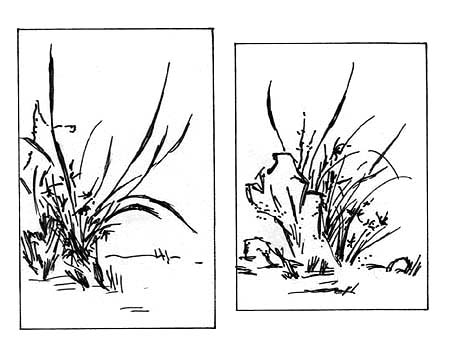|
||
 |
||

ü@
(C)2001 Japanese Architecture and Art Net Users System.ü@No reproduction or republication without written permission.
īfŹ┌é╠āeāLāXāgüEÄ╩É^üEāCāēāXāgé╚éŪüAæSé─é╠āRāōāeāōācé╠¢│ÆfĢĪÉ╗üEō]Ź┌éŗųéČé▄éĘüB
|
||||||
| ü@ | ||||||
| bokuranü@¢nŚ¢ | ||||||
| KEY WORD :ü@art history / paintings | ||||||
| ü@ | ||||||
| Ch: molan. Paintings of wild orchids rendered in *sumi ¢n ink. Related to paintings of ink bamboo *bokuchiku ¢nÆ|, and ink plum *bokubai ¢nö~. The wild orchid has been associated with the virtues of high-minded gentlemen since the Eastern Zhou dynasty, when poet Qu Yuan (Jp: Kutsu Gen ŗ³ī┤; ca. 340-280 BC) praised the frail, modest bloom, delicate fragrance, and appearance of the plant in unobtrusive places. The wild orchid is counted among the *shikunshi ÄlīNÄq (four gentlemen). Its long, smooth leaves are well-suited to expressive rendering in ink wash *bokugi ¢nŗY. Monochrome paintings of orchids date from the Northern Song dynasty, but became popular with painters of the Southern Song dynasty and Yuan dynasty such as Zhao Mengjian (Jp: Chou Mouken µŌ¢ąīś; 1199-1295), and Zhao Mengfu (Jp: Chou Moufu µŌ¢ąéė; 1254-1322), who used the image to symbolize China under alien Mongol rule. The Zen æT monk, Xuechuang (Jp: Sessou Éßæŗ; ?-1349?), combined the orchid with rocks, bamboo, and old trees in a hanging scroll painting in the Imperial Household Agency, Tokyo he also wrote a treatise, Hualan Bifaji (Jp: GARAN HIPPOUKI ēµŚ¢ĢM¢@ŗL) on the flower. Ink orchid painting came to Japan in the 14c and was a favorite subject of the Zen priest painters, Tesshuu Tokusai ōSÅMō┐ŹŽ (?-1366) and Gyokuen Bonpou ŗ╩é”é±×É¢F (?-1420?). The theme, as revived by *nanga ōņēµ painters in the 19c, is exemplified in several paintings by Tsubaki Chinzan ÆųÆųÄR (1801-54). | ||||||
| ü@ | ||||||
 |
||||||
ü@ |
||||||
| REFERENCES: | ||||||
| ü@ | ||||||
| EXTERNAL LINKS: | ||||||
| rankei douhou-zu Ś¢¹øō»¢FÉ} at Tokyo National Museumü@ü@ | ||||||
| NOTES: | ||||||
| ü@ | ||||||
(C)2001 Japanese Architecture and Art Net Users System.ü@No reproduction or republication without written permission. īfŹ┌é╠āeāLāXāgüEÄ╩É^üEāCāēāXāgé╚éŪüAæSé─é╠āRāōāeāōācé╠¢│ÆfĢĪÉ╗üEō]Ź┌éŗųéČé▄éĘüB |
||||||
| ü@ |